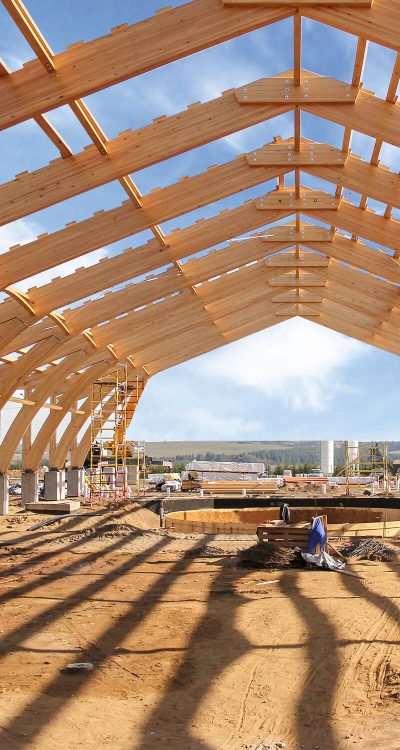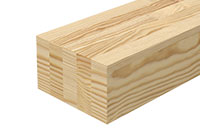A complete roof structure, which is prepared for tiling or sheeting, consists of many components. The rafter framing is the frame of the roof that carries heavy loads. It includes own weight, roofing, residual snow, wind and rain. The individual elements of the rafter framing need a solid connection, and this is provided by Klimas Wkręt-met construction screws. The basic element of the rafter framing are the roof trusses, which support the entire roofing resting on battens, counter-battens or boarding, under which the rafters are located. The roof trusses rest on the beams of the attic floor and on the wall itself through the wall plates.
The traditional construction of the rafter framing allows the attic to be adapted as usable. The structure is made of wooden elements such as beams, logs, battens and planks, which are connected by carpentry screws. The timber used for the structure is usually coniferous. Connections with construction screws are extremely important and the safety of the completed structure largely depends on them.

RAFTERS
Rafters are the structural element on which the entire roofing is supported. In practice, these are beams of rectangular cross-section, usually 7×14 or 8×16 cm, spaced at 80-120 cm. Apart from the material itself, which should come from a reliable source and be properly prepared, the most important thing is to fix the rafters with construction screws. Fastening with carpentry screws to the rafters is done at the daps. The daps mark the precise location of the construction screws.
Proper installation may be preceded by pre-drilling the rafters, but if you have carpentry screws with a milling tip, this is not necessary. The construction screw should pass perpendicularly through the plane of the rafter and connect to the purlin. For rafters with a small angle, it is important that the construction screws do not pass through the centre of the dap. This is because such a position poses the risk of the fastener slipping along the vertical surface of the purlin.
The length of carpentry screws should take into account both materials through which the installation is carried out. When starting carpentry work, both the length and type of construction screws should be selected properly. WKFS and WKFC wood construction screws with full threads are an interesting solution. These work well in places where it is important to reinforce the structure. The Klimas Wkręt-met offer includes carpentry screws for wooden structures, which have been equipped with a special milling tip, significantly reducing working time and increasing its ergonomics.
When carrying out construction work, it is essential to observe the basic principles of the art of construction. If the roof structure is not properly executed, it jeopardises the safety of the user. The most common mistake contractors make is to connect the structure improperly. Although they use construction screws, their installation or the positioning of the construction elements themselves is not proper. Another common mistake is to interrupt the structure, for example in favour of a chimney. Such a situation should have been foreseen in the design and the battens should have been placed on both sides of the chimney. Another mistake is improperly fitting the elements and omitting them. Unfortunately, very often as a result of construction errors, roof angles are not respected, which results in the roof sheathing not being possible or making it very difficult.
WHY SCREWS?
Screws are increasingly replacing carpentry nails due to their advantages and functionality. Construction screws carry significantly higher loads. Depending on the head, they tighten the fastened component well or reduce stress. Carpentry screws ensure greater rigidity of the structure, which translates into easier adaptation of the attic, e.g. finished with plasterboard. Plasterboards screwed to a rigid structure will work less and thus will be less prone to cracking. A rafter framing that is properly connected with construction screws will also have a higher load-bearing capacity, making it much more resistant to wind gusts and residual snow.
Carpentry screws are also economical and ergonomic. Connections are made faster and more precisely. Screwing is effortless thanks to the additional cutting notches that effectively cut through the wood fibres and the wax coating with which the carpentry screws are coated. The possibility of correction is an important advantage of installation with construction screws; a misplaced carpentry screw can be unscrewed and then installed in a different location or at a different angle. With construction screws, it is also possible to correct the geometry of the structure, if necessary. The older solution of nails precludes any corrections.
Carpentry screws have a wide range of applications; on the one hand, they are the strongest constructional connection, on the other hand, they make it possible to install over-rafter insulation. Such insulation is becoming increasingly popular thanks to its excellent thermal insulation properties.
QUALITY GUARANTEE
Only certified, reliable and proven products should be used in construction work. Construction carpentry screws are covered by design requirements and therefore receive technical approvals such as ETA, with which we can guarantee not only correct workmanship but also a long service life of the structure.
PROPER SELECTION OF SCREWS
Apart from simple tips for simple connections, structural issues and even more so the construction of the rafter framing should be dealt with by a certified structural engineer. Strength calculations and the correctness of carpentry connections should be specified in the construction design. By carrying out the work in accordance with the construction design, we are responsible for the workmanship itself, not the design. Workmanship should be in accordance with the design and there is no room for deviation or personal interpretation. If the construction is carried out using training materials or training programmes offered by producers and trainers, it must be remembered that such calculations are advisory and not design-related. Only the approval of the distribution of carpentry screws as well as any other type of fastening by a certified designer protects us in the event of incorrect calculations.
Often, however, roofers and carpenters act independently during simple work or structural reinforcement work. Then it is good to follow the rule of too strong connection. Fitting additional fasteners to the structure is definitely safer than omitting essential components.




